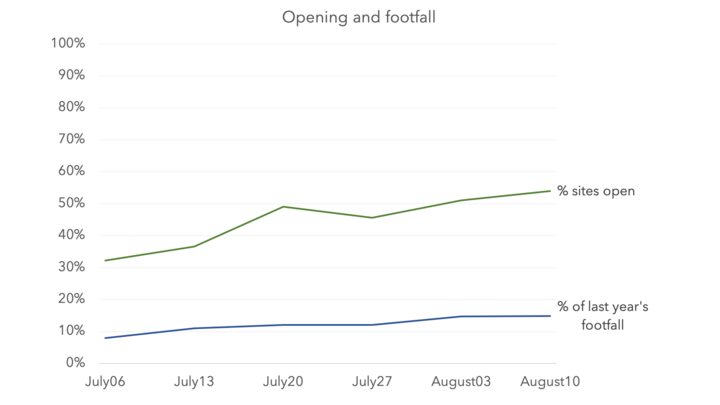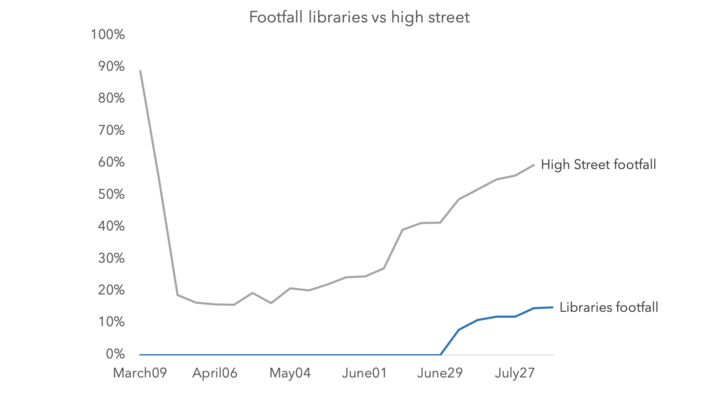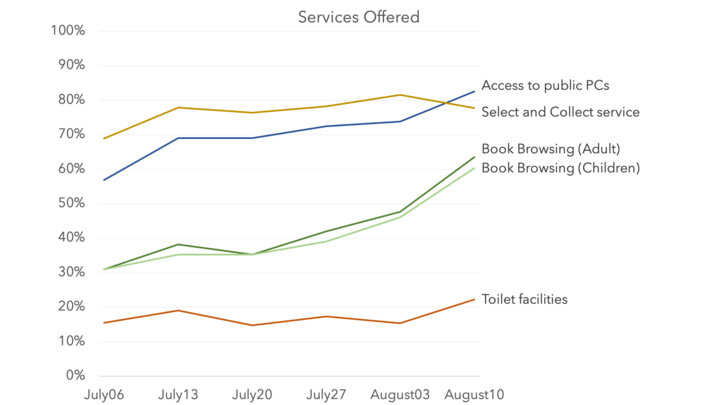We’re back! How public libraries have been reopening their doors
Aug 25, 2020
"Almost 4 months without access to a library was a real hard time for some of us without internet connection at home. It is extremely nice that you have eventually opened the library at this difficult time". Newham Library Member.
As high streets, businesses and the wider economy starts to open, we’ve been collecting data about how public library services have been reopening. We have just a snapshot of around 1 in 3 public libraries at the moment, but we’ll be collecting this data over the coming months to build up a more detailed picture of how library services are recovering.
What we’re finding sheds light on how libraries are contributing to the recovery of society after lockdown. A high priority has been providing public computer access, so that people can apply for online services such as universal credit or find and apply for jobs. In fact, in mid-August, more libraries were offering computer access than access to the shelves for browsing books. Arts Council England have shared more information to show how libraries are helping local communities find work.
How far have libraries got with reopening?
We worked with Heads of Service and government experts to develop a Service Recovery Toolkit. This set out an indicative recovery path for libraries, with a gradual return of services, to allow time for new processes to be implemented, staff trained and buildings made ready.
In practice, it has proved to be a complex operation and our tracking data has shown that services that reopened in the first couple of weeks opened only a third of their sites. However, now over half of library sites are open, including many major town and city centre sites. In mid-August, only two library services had no sites open but all were continuing with remote and digital services for their residents.
Libraries have spoken to us about the main challenges of reopening, and some common patterns have emerged about staff availability (as COVID-safe procedures need increased staffing), ensuring adequate ventilation and increasing cleaning regimes. The new safety procedures have been welcomed by users, with many libraries reporting positive comments similar to this one.
Normanton Library Customer:
"I went to the library today for the first time since covid started. The staff were fantastic, reassuring and as an anxiety sufferer I felt extremely comfortable. The procedures were second to none. Big thank you, I can read to relax".
Libraries are also trying to restore their Home Library Services for vulnerable users. A few libraries were able to maintain this service during lockdown, and it proved a lifeline for many – as much for the human contact as the books and resources it delivers.
Telford and Wrekin Home Library Service User:
"I am so grateful to Amy and the Library for my audiobook delivery I would be lost without them, it’s another dimension to a long day and she always makes my day when she brings them. She has been wonderful phoning up during the Coronavirus and checking I’m ok even though they couldn’t bring new audiobooks and because I’ve been stuck in without any visitors or my cleaner it’s been so nice to have another voice and new books to read".
Library footfall

In terms of footfall however, it’s taking a little longer to get back up to speed.
In the first week of opening, libraries saw 8% of their usual visitor numbers, and over the six weeks to mid- august this rose to 15%. However, this comparison is based on footfall numbers last year when all library sites were open, so with the 15% figure is more likely to be between 20 and 40% of usual footfall for those sites that are open. We are expecting footfall to grow sharply as more buildings reopen and as more services come back on stream.
It is interesting to compare this with high street footfall data – bearing in mind that the high street started reopening at the start of June and never fully closed in the way that libraries did. We can see that the first steps of libraries opening are roughly consistent with the earlier high street growth, though clearly there’s still a long way to go. Heads of Service are also reporting the variation in footfall at different branches – with local branches in residential areas doing well, and footfall in town and city centres lagging behind as people are still not travelling into these areas for work or shopping. This is a pattern we hope to gather more data on over the next few weeks.

What services are available in libraries?
Our toolkit for reopening suggested a phased plan of reopening and this is being put in place by many library services. Most services started with some form of Order & Collect – where users collect packaged books from the library lobby. However, a few libraries were able to offer browsing and PC access from the start, and every week more libraries are able to offer these services.
Access to public PCs has been recognised as a priority service – especially with increasing numbers of people out of work and needing to apply for jobs and benefits. PC access is now provided by more than 80% of all library services and anecdotal data suggests this is in high demand. Having sampled a couple of sites we’re seeing trends emerge:
- At one site 84% of people were using library computers to access online services such as universal credit and half were using it to keep in touch with friends and family
- At another site 45% were of working age but not currently in employment and 1 in 4 of them were specifically using the PCs to seek work.
This is just a snapshot of two libraries, and gives a flavour, but Arts Council England are carrying out research in this area to get a much more representative picture.

The other rapidly changing service is book browsing. It has taken a little time to find a way to reopen the shelves safely, but now more than 60% of library services are offering browsing for adult and – in many cases – children.
Next steps
Libraries are starting to plan the next phase of reopening, to be able to welcome people back into the library for longer visits, group activities and events. We hope to see some services piloting these activities in September, so we will share the learning and good practice ideas across the whole library network.
Like all publicly funded services, libraries will face enormous challenges over the next two or three years. The Institute of Fiscal Studies has estimated that councils face a £2.2bn funding gap due to the pandemic.
Running libraries in a this new environment is more expensive, as extra staff are needed, for example to manage queues or run Order & Collect and expanded Home Library Services alongside browsing. Most libraries want to sustain their improved digital offer, but eBooks are more costly than paper copies, and additional skilled staff may be needed to continue to offer online events such as storytimes and reading groups.
The future won’t be easy – and underlying the reopening is careful work to tailor services to the needs of the communities they serve. We believe that libraries are making vital contributions to the recovery of their communities, with clear impacts on local economies, tackling isolation and educational and digital inequalities, and helping the recovery of the local cultural sector. We have collated evidence to support these claims in our recent publication, Libraries: an essential part of local recovery.
As a core part of communities, libraries are focusing on what their members and local beneficiaries need them to provide and looking to play a key role in the wider reopening of villages, towns and cities. We have a lot of work ahead, but recovery is well underway.
